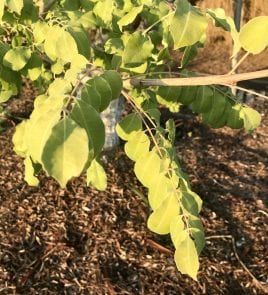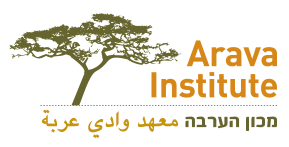
DEVELOPING ARGAN AS A COMMERCIAL CROP IN THE ARAVA VALLEY
Since 1982, Dr. Solowey has grown Argania spinosa. The squat, thorny tree has gained popularity in recent years as the market for the prized oil has exploded. The research aims to understand the tree’s physiology, fruiting and flowering cycles, genetics, propagation, soil needs, and general environment that support the tree’s flourishing. The argan originates in Morocco and northern Algeria and has not yet successfully been domesticated for production. The long-term research that Dr. Solowey promotes will further the understanding and domestication of the species. One technique used is selection and hybridization, a process of purposely causing the trees to mate by isolating and pollinating them, causing genetic materials to combine in the flowers.
In Israel, Argania is already well on its way to becoming a commercial crop; new aspects include studying nut yield and the mechanization of oil production, in collaboration with Dr. Giora Ben Ari (Israeli Agricultural Research Organization) and other research facilities across the country.
Crop Trials and Drylands Agriculture

Dr. Solowey began her work with the marula tree (Sclerocarya birrea and Sclerocarya caffra) in the early 1980’s in order to improve the fruit quality. The Center crossbred the trees until the fruit quality improved. It proved an easy tree to propagate and has since been distributed for use and further research to many sites in Israel. The first commercial planting of the new Marula tree is expected in 2019 in Almog, Israel.
The marula is widespread in Africa from Ethiopia until eastern South Africa. It grows naturally in various types of woodland on sandy soil. It has been discovered that the marula tolerates the difficult conditions of the hyper-arid Arava desert quite well. The marula manages with saline and alkaline water, low levels of irrigation, and is widely used for landscaping due to its elegant shape and shade coverage. Apart from new crop development and fruit quality improvement, the oil can be used for cosmetics and the fruit has been developed (not by The Center) into liquor and marketed locally.
Dr. Solowey has been published about her knowledge of the tree in the book Lost Crops of Africa Vol 3 produced by The Smithsonian. Her chapter details methodology and crop grooming.
Shelef, O., Guy, O., Solowey, E., Kam, M., Degen, A. A., & Rachmilevitch, S. (2016). Domestication of plants for sustainable agriculture in drylands: Experience from the Negev Desert. Arid Land Research and Management, 30(2), 209–228. doi: 10.1080/15324982.2015.1089954
Solowey, E., Amede, T., Evans, A., Boelee, E., & Bindraban, P. (n.d.). 6 Drylands. In Managing Water and Agroecosystems for Food Security(1st ed., Vol. 10, pp. 68–81). Wallingford: CABI.
Rabia, K. A., Solowey, E., & Leu, S. (2008). Environmental and economic potential of Bedouin dryland agriculture. Management of Environmental Quality: An International Journal, 19(3), 353–366. doi: 10.1108/14777830810866464
Solowey, E. Growing Bread On Trees, published by Thistle Syndicate/Bibliobooks, November 2010. A book about the potential of perennial agriculture
Solowey, E. Supping At God’s Table, published by the Thistle Syndicate/Rosenzweig Coopersmith Foundation/Bibliobooks in June 2006. A book about the domestication and development of wild fruit trees.
Solowey, E. Small Steps Towards Abundance, published by Thistle Syndicate/Bibliobooks, 2003. A book about crops for sustainable agriculture.
Contributed to:
Dafforn , M., & Vietmeyer, N. (2008). Lost Crops of Africa: Fruit (Vol. 3). Washington, D.C.: National Academies Press.
Trial Crops in Partnership with Dr. Yosef Mizrahi and Ben Gurion University
| Botanical Name | Common Name | Family | Distribution | Ongoing |
|---|---|---|---|---|
| Lucuma caimito | Abiu | SAPOTACEAE | Trop. America | |
| Harpephyllum caffrum | African Plum | ANACARDIACEAE | S. Africa | |
| Spondias cytherea (Spondias dulcis) | Ambarella | ANACARDIACEAE | Polynesia | |
| Mimusops angel | Angel | SAPOTACEAE | Somalia | ongoing |
| Argania spinosa | Argan | SAPOTACEAE | Morocco | ongoing |
| Ziziphus mauritiana | Ber | RHAMNACEAE | Old World Tropics | ongoing |
| Diospyros digyna | Black Sapote | EBENACEAE | S. America | ongoing |
| Pachycereus pringlei | Cardon pelon | CACTACEAE | Sonoroan Desert | ongoing |
| Carissa grandiflora | Carissa | APOCYNACEAE | S. America | |
| Cyrtocarpa edulis | Ciruelo | ANACARDIACEAE | Baja Ca, Mexico | |
| Artocaprus heterophyllus | Jackfruit | MORACEAE | Asia | |
| Inga vera &spp. | Ice cream bean | MIMOSACEAE | S. America | |
| Dovyalis caffra | Kei apple | FLACOURTIACEAE | S. Africa | ongoing |
| Diospyros discolor | Mabolo (Velvet Apple) | EBENACEAE | Phillipean Islands | ongoing |
| Bombax glabra | Malabar nut | BOMBACACEAE | Central America | ongoing |
| Pouteria sapota | Mammey sapote | SAPOTACEAE | Central America | ongoing |
| Garcinia mangostana | Mangosteen | GUTTIFERAE | SE Asia | |
| Sclerocarya birrea subsp. caffra | Marula (Morula) | ANACARDIACEAE | S. Africa | ongoing |
| Vangueria infausta | Mmilo | RUBIACEAE | S. Africa | |
| Diospyros mespiliformis | Mmilo (Namibia) | EBENACEAE | S. Africa | ongoing |
| Ricinodendron rautanenii | Mongongo | EUPHORBIACEAE | S. Africa | unknown |
| Strychnos cocculoides | Monkey Orange | LOGANIACEAE | S. Africa | |
| Strychnos spinosa | Monkey Orange | LOGANIACEAE | S. Africa | |
| Strychnos pungens | Monkey Orange | LOGANIACEAE | S. Africa | |
| Hylocereus sp 2 yellow types (amarilla) | Pitahaya* | CACTACEAE | Central America | |
| Hylocereus costaricensis | Pitahaya | CACTACEAE | Central America | |
| Hylocereus paolyrhi | Pitahaya | CACTACEAE | Central America | |
| Hylocereus polyrhizus | Pitahaya | CACTACEAE | Central America | |
| Hylocereus purpusii | Pitahaya | CACTACEAE | Central America | |
| Hylocereus undatus 2 cultivars | Pitahaya inc. polimisceus | CACTACEAE | Central America | |
| Hylocereus sp 8 types, 22 cultivars | Pitahaya* inc. polimihi | CACTACEAE | Central America | |
| Cereus peruvianus | Pitahaya | CACTACEAE | North S. America | ongoing |
| Stenocereus gummosus | Pitahaya agria | CACTACEAE | Sonoroan Desert | |
| Stenocereus griseus | Pitahaya | CACTACEAE | Sonoroan Desert | |
| Stenocereus thurberi | Pitahaya dulce | CACTACEAE | Sonoroan Desert | |
| Stenocereus thurberi var litoralis | Pitahaya dulce | CACTACEAE | Sonoroan Desert | |
| Opuntia ficus-indica &spp.20 cultivars | Prickly Pear | CACTACEAE | Trop. America | ongoing |
| Santalum acuminatum | Quandong | SANTALACEAE | Australia | |
| Hovenia dulcis | Raisin Tree | MYRTACEAE | E. Asia | |
| Manilkara zapota | Sapodilla | SAPOTACEAE | India, Africa, C. America | ongoing |
| Annona muricota | Soursop (Guanabana) | ANNONACEAE | North S. America | |
| Chrysophyllum cainito | Star apple | SAPOTACEAE | Central America | |
| Tamarindus indica | Tamarind | LEGUMINOSAE | Trop. Africa | ongoing |
| Casimiroa edulis | White sapote | RUTACEAE | Mexico, C. America | |
| Cordeauxia edulis | Yehib | CAESALPINIACEAE | NE Africa |

